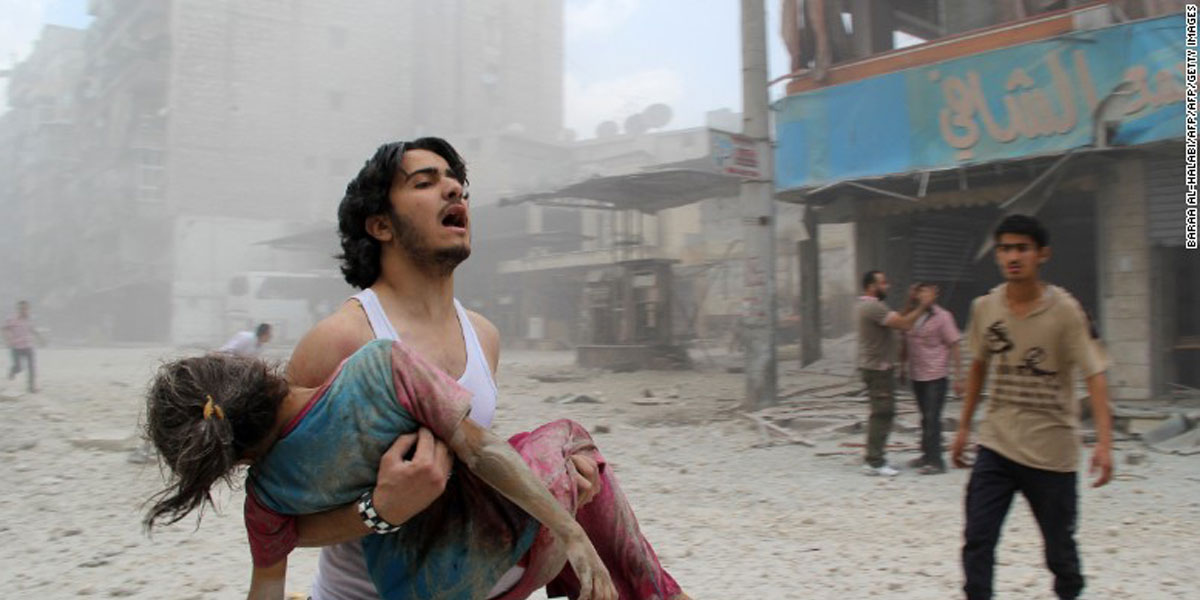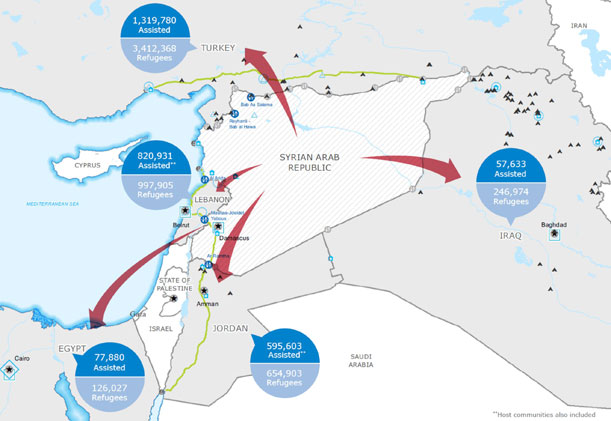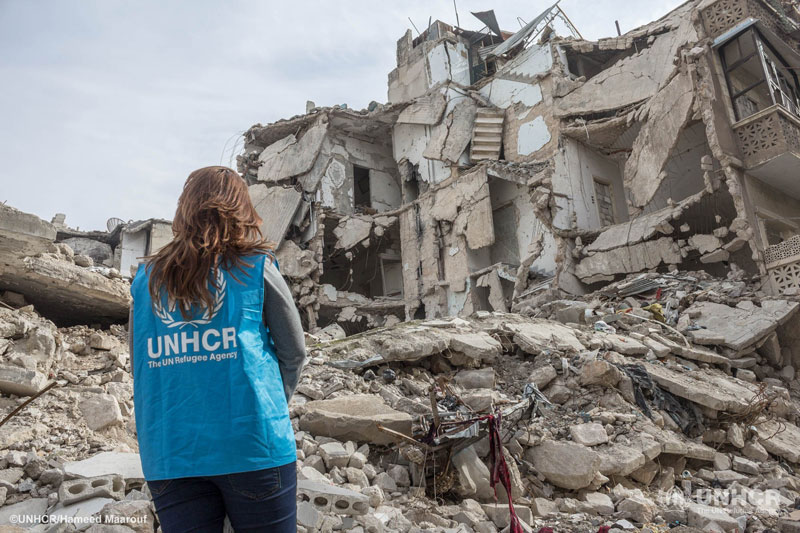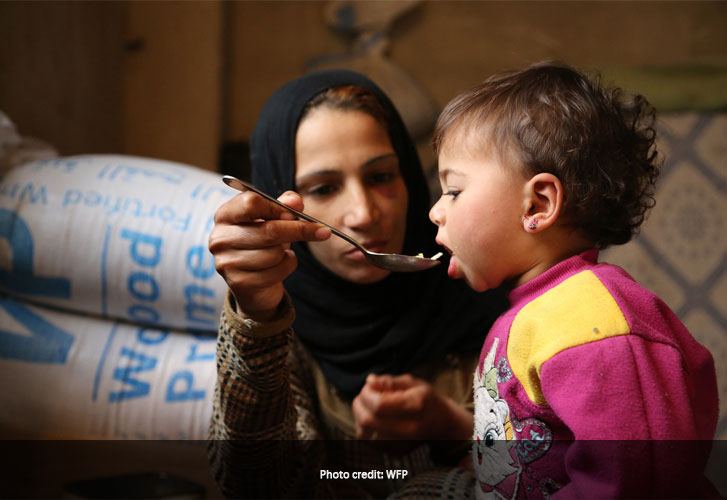
The humanitarian emergency
The seven-year-old Syrian conflict has produced the world’s largest refugee crisis. More than half of Syrians have been forced to flee their homes because of war — 5.5 million have fled the country and 6 million more have been driven from their homes but remain in Syria.
Seven years into the conflict in the Syrian Arab Republic, the scale, severity and complexity of needs across the country remain overwhelming. Some 13.1 million people require humanitarian assistance, including 6.1 million internally displaced persons.
Although millions of Syrians have escaped the war at home and found refuge in neighboring countries, many are unable to escape poverty and the challenges of living in exile. Ninety percent of Syrian refugees live in rural areas in makeshift shelters, or in urban centers, often in overcrowded and dangerous locations.
Syrian refugees struggle to access medical care, schools for their children, employment and food. In Jordan, 80 percent of Syrian refugees living outside of camps live below the poverty line. In Lebanon, 91 percent of families are currently at risk of food insecurity.
The latest displacement has been in Eastern Ghouta. 45,000 men, women and children driven from Eastern Ghouta by war, are currently seeking safety at collective shelters in and around the Syrian capital Damascus. Most of the residents have been trapped for five years by fighting.

Background
On March 15, the Syrian war entered its eighth year.
More than 465,000 Syrians have lost their lives in seven years of armed conflict, over a million injured, and over 12 million—half the country’s prewar population—have been displaced from their homes. The conflict began in 2011 with anti-government protests before escalating into a full-scale civil war as forces loyal to President Bashar al-Assad and those opposed to his rule battle each other – as well as jihadist militants from Islamic State. Foreign backing and open intervention have played a large role in Syria’s civil war.
What is the UN doing to help?
UNHCR, UNICEF, WFP and UNFPA are on the ground addressing the humanitarian crisis.
EMERGENCY SHELTER

UNHCR has been on the ground since the beginning of the conflict coordinating a massive refugee response. Throughout the region, the UN Refugee Agency is leading efforts to protect and provide shelter for those displaced inside Syria – working across conflict lines to provide critical aid under extremely dangerous circumstances.
UNHCR provides life-saving humanitarian aid for Syrian refugees, helping the most vulnerable with cash for medicine and food, stoves and fuel for heating, insulation for tents, thermal blankets and winter clothing. For those who have been displaced but remain in Syria, UNHCR provides shelter kits and non-food items as well as protection services and psychosocial support.
Millions of Syrians have received winter assistance – essentials to help keep people alive in sub-zero temperatures. Last year, over 4 million people within Syria received basic relief items – like food, medicine, bedding and utensils.
FOOD ASSISTANCE

From the onset of the Syrian crisis in 2011, WFP has been on the frontlines doing whatever it takes to deliver food to millions of people who need it.
Within Syria, every month, WFP uses over 4,600 trucks to deliver emergency food assistance to 900 distribution points in all 14 governorates. In besieged and hard-to reach areas, where regular deliveries are not possible and humanitarian needs are extremely high, WFP employs creative solutions, including inter-agency cross-line convoys, as well as airlifts and high-altitude airdrops. WFP also conducts cross-border deliveries from Jordan and Turkey to bring food assistance to opposition-held areas in northern and southern Syria. Working with over 50 local and international partners, WFP distributes food to between 4 and 5 million people every month.
However, continuous fighting has forced close to 5 million people to flee across Syria’s borders in search of safety elsewhere. Life outside Syria has pushed many refugee families into extreme poverty, leaving them unable to put food on the table or send their children to school. Some of the most vulnerable refugees are taking extreme measures to cope, including returning to Syria or leaving host countries for elsewhere.
WFP supports almost 1.6 million of the most vulnerable Syrian refugees sheltering in Lebanon, Jordan, Turkey, Egypt and Iraq. Through its voucher programme, WFP is empowering families to purchase food of their choice from local shops, including fresh produce, dairy products, meat and chicken.
Through these programmes, WFP has injected over US$ 2 billion into the economies of the countries neighbouring Syria. As the largest humanitarian food voucher programme worldwide, it is strengthening local markets, creating jobs, and increasing demand for local produce.
Every month, WFP is providing family food rations to more than 4 million displaced and conflict-affected people across Syria. Each ration is enough to feed a family of five. In neighbouring countries, WFP assists Syrian refugees and vulnerable host communities with electronic vouchers.
WFP supports the education of Syrian children by providing nutritious snacks in almost 900 schools across Syria, as well as through school meals initiatives in Egypt, Jordan and Lebanon.
CHILDREN
Children have paid the heaviest price in the conflict, and their suffering has hit rock bottom in a drastic escalation of violence. Nearly 6 million children are in need of humanitarian assistance, with almost half forced to flee their homes. Seven years of conflict have taken an immense toll on the most vulnerable, and sadly, for the youngest Syrians, there are dire consequences for the future. Less than half of elementary school aged children are enrolled in school and only a fraction of high school and college aged students have access to education.
UNICEF and its partners are committed to delivering essential services for Syrian families and keeping Syrian children from becoming a ‘lost generation’. Critical efforts are being made to minimize the impact of the crisis on children – including in the life-saving areas of health, nutrition, immunization, water and sanitation, as well as education and child protection.
UNICEF is screening 1.7 million children and pregnant and lactating women for acute malnutrition, ensuring 13.5 million people have sustained access to safe drinking water, and enrolling 2.2 million children aged 5 to 17 in formal general education.
Of the estimated 8.35 million children living in the Syrian Arab Republic, 5.3 million require humanitarian assistance, 1.2 million live in hard-to-reach areas and 170,000 live in besieged areas. More than 3 million children under 5 years require nutrition support, including the nearly 20,000 children suffering from severe acute malnutrition (SAM). The suffering of children in besieged areas remains a key concern, including with the rapid deterioration of the nutrition situation in Eastern Ghouta. Grave child rights violations continue, with countless children killed and injured by the persistent use of explosive weapons in civilian areas and the recruitment and use of children in armed conflict, as well as torture, detention, abduction, sexual violence, attacks on schools and hospitals and the denial of humanitarian access, particularly to children living in United Nations-declared besieged areas.